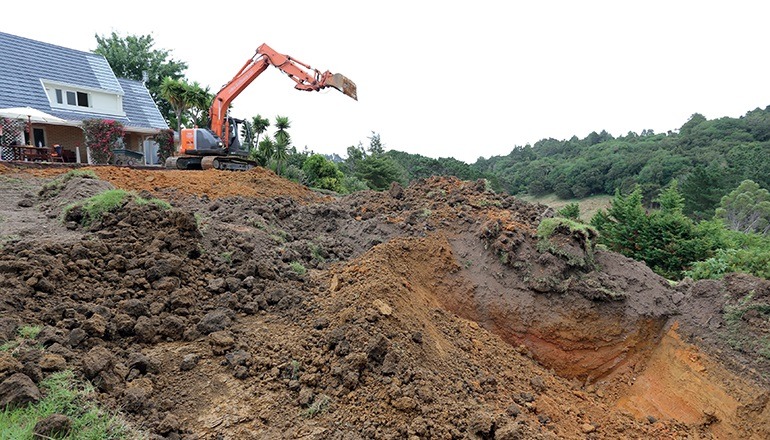ALAN TITCHALL visits excavator maestro Brian Hoffman while he is working on a tricky swimming pool site in Auckland.
THE SHARED DRIVEWAY is stepped and congested with trees. A trail of ripped leaves leads me to a large house. An excavator is clattering away at the rear.

“Yeah it was a tight job alright,” says Brian Hoffman. “Did you notice all the trees?
“ And we had five neighbours to consider who use that driveway. We couldn’t start to haul the pool structure down here until they had all gone to work and taken the kids to school.”
While it took two hours to get the 45,000-litre pool shell down to the site, he completed the excavator work in an hour.
Brian shouldn’t need an introduction. As a skilled excavator operator he has participated in every National Excavator Operator Competition held by the Civil Contractors’ association over the past decade. He has won the national title twice, and was the defending champ at this year’s event.
I caught up with Brian just a week before the competition to be briefed on the art of swimming pool making.
I confess a fascination with backyard swimming pools having looked after one for 15 years. When I bought our house in Auckland our pool was already local folklore, as the previous owner had decided to excavate the hole himself.
Striking a sizable basalt flow he did what any enterprising DIY Kiwi bloke would do in the same circumstance, got some explosives from a mate in the quarry business and blew a dirty big hole in the rock. Unfortunately, he also took out every neighbourhood window in a 100-metre radius and the older residents in our street are still fond of reminding me of the event.
 These days Brian Hoffmann doesn’t use explosives to dig swimming pool holes, although he remembers a time when he did.
These days Brian Hoffmann doesn’t use explosives to dig swimming pool holes, although he remembers a time when he did.
“Drill a hole with a jackhammer, fill it with explosive and a detonator, put sacks all round it, a thick steel plate on top, then rubber tyres, and then put the digger on top. When it blew the whole lot would jump in the air. Occasionally the odd rock would fly out from the sacks. No health and safety back in those days.”
Brian started with Trevor Boag in 1972. Trevor was a well-liked contractor and at one stage was the president of the old Contractors’ Federation.
“When Trevor started there weren’t many hydraulic excavators around – maybe the odd Massey Ferguson. When the Japanese machines came onto the market he bought an Hitachi, and that is the brand I have stuck with. I swear by them,” says Brian.
These days Hoffman Excavators can be installing a pool every day of the week. Through another business, Aquatechnics (a large retail business also located in Auckland), Brian imports fibreglass pools from Australia. They are easier to install than a concrete one, he says. And they are usually rectangle.
“Concrete and kidney shaped pools were popular back in the 1970s and 1980s. Now you can’t sell a pool with a curve in it. Although, that could change back, who knows?”
A pool with a view

The rural view from the rear of the house looks north and stretches over a forested valley. It is an ideal spot to cool off during Auckland notoriously humid summers.
All pool sites have their challenges and even level sites in residential areas can present very restricted spaces for an excavator.
In this case there was plenty of room for the excavator, the ground sloped away from the house and had to be levelled.
“First you have to strip away the grass as you can’t put fill on grass. The grass will rot and create a slippery back under the fill that can cause a slip.
“Then you have to bench the slopes – key-in the fill with steps, so when the fill goes on top it won’t slide down the hill with the first rain.
“This is where a lot of guys go wrong – they don’t strip the grass, or key-in.”
The job started with a ‘borrow pit’ from which Brian took clay fill to level out the site and then compacted it by track rolling.
 “The ground needs to be firm to support the sides of the pool shell, which is not self-supporting,” says Brian.
“The ground needs to be firm to support the sides of the pool shell, which is not self-supporting,” says Brian.
The pool hole is large enough to accommodate a back-fill and bed of scoria and a Topcon – self-levelling laser is used so they don’t over dig.
The size of the pool on the levelled site is marked out and Brian has offset the positions earlier on to save time, as is standard with any excavation.
The hole was then excavated and the fill returned to the borrow pit. The job is done in a matter of hours.
“There’s a lot in each job and not just a matter of digging a hole and plonking in a pool structure, and my motto is do it once and do it properly,” says Brian.
“I want these owners to be happy with their pool and spread the word among family and friends.”

